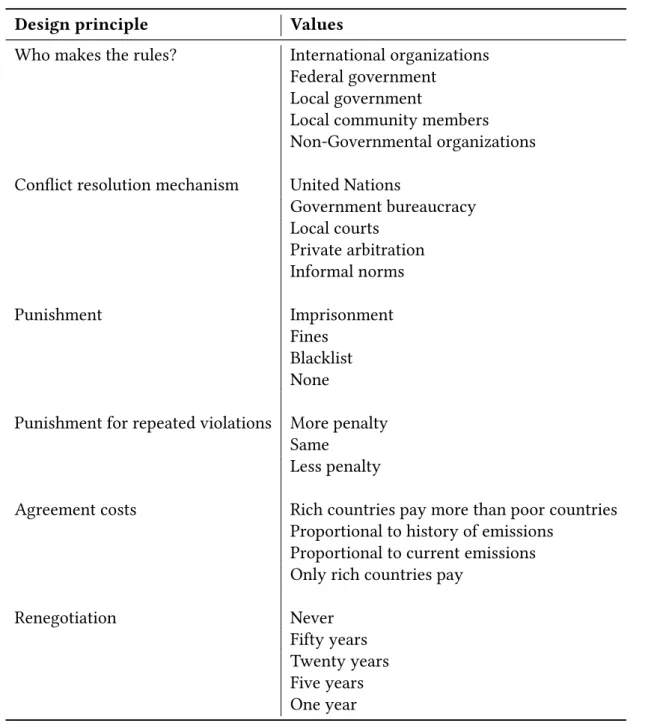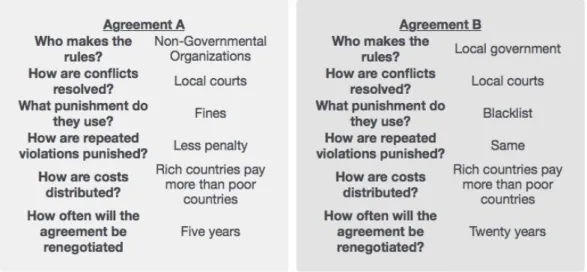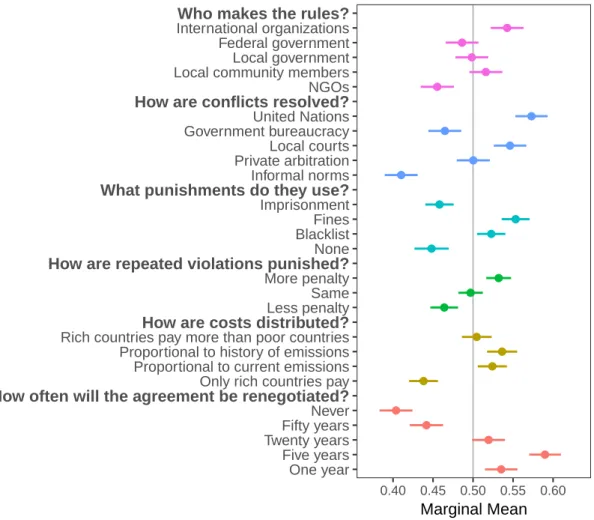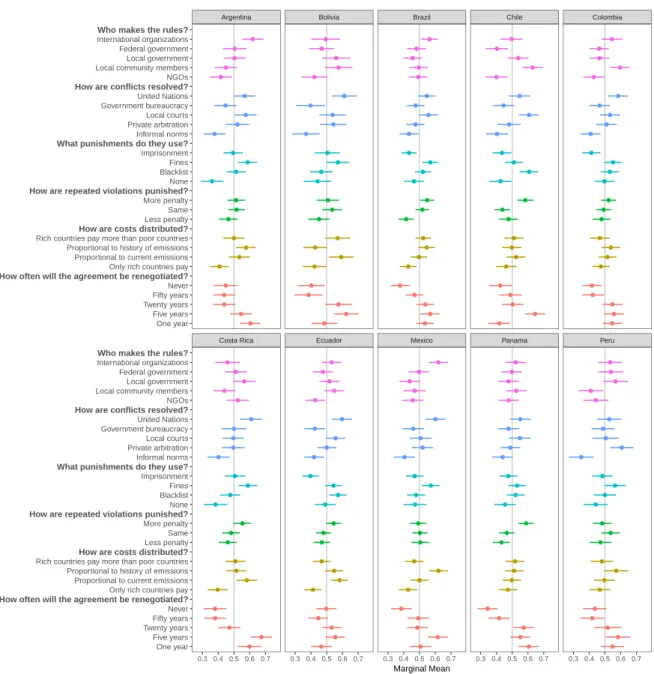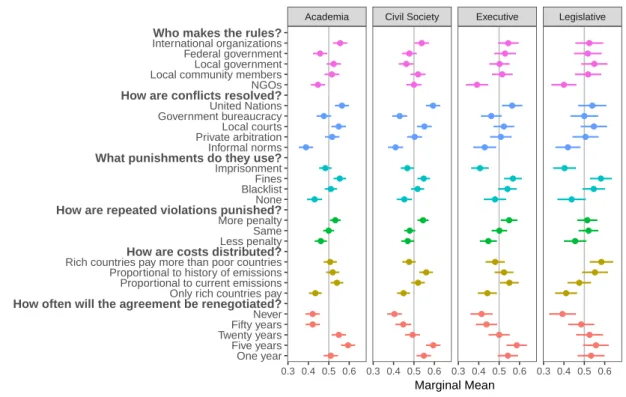Latin American elites favor polycentric governance
in climate change agreements
Danilo Freire
1*
Umberto Mignozzetti
2David Skarbek
321 January 2019
Abstract
Scholars and policy-makers generally assume that climate change mitigation requires global scale governance. However, the international provision of public goods is particularly sus-ceptible to free riders and poor monitoring. Nobel laureate Elinor Ostrom argued that a de-centralized approach to climate governance might be able to address these issues by fostering trust among members of the civil society and generating the local knowledge necessary to effectively implement climate policies. Here we run a conjoint experiment with elite members of 10 Latin American countries and ask respondents to evaluate 6,000 possible climate change agreements that vary across six dimensions. We find that Latin American elites strongly prefer polycentric regimes to centralized ones, and the result is robust across countries and elite types. These findings not only suggest novel ways to craft democratic climate change mitigation agreements, but also offer new insights on how to integrate interventions at the local and international levels.
Keywords: climate change, conjoint experiment, elites, Latin America, polycentrism
Over the past years, we have seen an emerging consensus about the causes and consequences of anthropogenic climate change. Despite some variation in climate risk beliefs, mostly due to
1The Political Theory Project, Brown University, Providence, RI, USA. *email: danilo_freire@brown.edu
2School of International Relations, Fundação Getulio Vargas, São Paulo, SP, Brazil and Wilf Family Department
of Politics, NYU, NY, USA.
cultural worldviews and political orientation [1], recent surveys show that the public is fully aware of the dangers of greenhouse gas emissions. For example, the share of Americans who are sure the Earth’s temperature is increasing is at an all-time high (59%) [2]; 74% of European Union citizens consider global warming a ‘very serious problem’ [3]; and 90% of Brazilians believe climate change is already harming people around the world [4].
Yet this consensus does not translate itself into effective political action. Global climate negoti-ations have progressed slowly under the guidelines of the United Nnegoti-ations Framework Convention on Climate Change (UNFCCC), and there is wide scepticism that multilateral talks will move faster in the next years [5,6]. As carbon dioxide emissions continue to increase, current efforts are likely to be insufficient to meet the Paris Agreement target of 2◦C temperature rise above pre-industrial levels [7]. Existing research affirms that this unsatisfactory performance is partially due to institutional design [8, 9, 10]. For instance, multilateral forums downplay the domestic constraints political leaders experience when implementing strategies to reduce greenhouse gas emissions [9]. In addition, universal binding agreements offer limited scope for experimentation and social learning, which hinders the ability for individuals to experiment and find solutions to complex collective action problems [11].
Many authors argue that polycentric governance approaches provide a good ‘institutional fit’ for natural resource systems [12,13,14,15]. Polycentrism is defined as a political arrangement in which formally independent units operating at different levels engage in a continuous process of cooperation and competition [5,16]. Recent experiences, such as with inshore fisheries in Turkey or timber management in Switzerland, show that polycentrism allows communities to induce individual cooperation and avoid the ‘tragedy of the commons’, that is, the overexploitation of shared resources [14, 17, 8]. Additionally, polycentrism places democratic accountability at the core of the political process. This has important benefits: Public deliberation and devolution of power not only reduce the scope of rent-seeking behavior, but also promote quick adaptation to bad use of public resources [17,8,10,15]. In that regard, multilevel institutions are conducive to trust-building and innovation, two key features of successful common pool resource management [18,16].
But despite the potential advantages of polycentrism, there is little evidence that citizens prefer polycentric institutions to fight climate change. Two potential challenges may undermine the
support for multilevel political arrangements. On the one hand, pluralistic systems demand high levels of civic engagement [16]. Since climate change has diffuse benefits but concentrated costs, individuals have a strong incentive not to join collective efforts. On the other hand, individuals tend to heavily discount climate change investments [19]. Reducing carbon emissions requires significant expenditures today, yet the benefits of climate mitigation will arise only in a distant future. Thus, individuals may abstain from taking part in initiatives that prevent climate change if they perceive long-term results as too uncertain or whose benefits will only be enjoyed by later generations.
We design a conjoint experiment to assess which type of climate change governance system Latin American elites are willing to support. Conjoint experiments allow respondents to evalu-ate two competing profiles that vary across multiple dimensions of interest, and under sensible assumptions, they can estimate the causal impact of each factor on the respondent’s decision [20, 21]. In our survey, we asked 651 “elites” – academics, members of the executive power, legislators, businesspeople, and members of non-governmental organizations – to select their preferred agreement in 7 randomized binary choices. Respondents were recruited from Argentina, Brazil, Bolivia, Chile, Colombia, Costa Rica, Ecuador, Mexico, Panama, and Peru.
We chose to survey Latin American elites for several reasons. First, Latin America is the most bio-diverse region in the world. The Amazon river basin is the largest preserved forest on Earth, and it contains about half of the world’s carbon stock [22]. Second, the region remains largely dependent on agriculture, so global warming will severely disrupt the Latin American economy [23]. For these two reasons, it is a substantively important set of cases. Lastly, Latin American elites have vast disagreements about societal issues. For instance, the rapid shifts between leftist and rightist governments, along with growing ideological polarization in the region, indicate that local elites are not a cohesive social group [24]. Latin American elites are capable of influencing if climate change solutions are pursued, but they might disagree more on which particular solutions to pursue. This makes it important to understand how they evaluate different characteristics of such solutions.
We formulate our experiment according to Elinor Ostrom’s ‘design principles’ of successful common pool resource management and selected our category values according to them [14,25]. The hypothetical climate change agreements includes six dimensions: 1) which organization
de-fines the rules; 2) how would conflicts be resolved; 3) what punishment should be applied to rule-breakers; 4) how should repeated violations be sanctioned; 5) which countries should bear the costs of the agreement; 6) how often should the agreement be renegotiated. Table1describes the values we included in each design principle.
Table 1:Design principles for climate change mitigation conjoint experiments.
Design principle Values
Who makes the rules? International organizations
Federal government Local government
Local community members Non-Governmental organizations
Conflict resolution mechanism United Nations
Government bureaucracy Local courts Private arbitration Informal norms Punishment Imprisonment Fines Blacklist None
Punishment for repeated violations More penalty Same
Less penalty
Agreement costs Rich countries pay more than poor countries
Proportional to history of emissions Proportional to current emissions Only rich countries pay
Renegotiation Never
Fifty years Twenty years Five years One year
Our six principles correspond to a standard set of resolutions international treaties are ex-pected to cover. However, the categories open the possibility for respondents to combine multiple levels of governance into a single climate change agreement as they see fit. We give no prior
indication of whether a certain value is more prevalent in actual agreements, and we randomise the values to ensure that they all have the same probability of being selected. In total, there are 6,000 possible value combinations. Figure1illustrates our experimental design.
Figure 1: Example of conjoint experiment design. We presented respondents with 7 binary
choices similar to this one. The values for the six design principles were randomly sampled from our list of attributes. More information is available in the Supplementary Appendix.
Figure2shows our main results. The findings indicate that Latin American elites have a strong preference for a polycentric approach to mitigate climate change. We see that the respondents have a positive view about two sources of climate governance, namely those located at the interna-tional and the local levels. Importantly, Latin American elites support both levelssimultaneously; this provides evidence that they favor agreements which incorporate action separate political spheres at the same time in the same regime.
● ● ● ● ● ● ● ● ● ● ● ● ● ● ● ● ● ● ● ● ● ● ● ● ● ● One year Five years Twenty years Fifty yearsNever
How often will the agreement be renegotiated?Only rich countries pay
Proportional to current emissions Proportional to history of emissions Rich countries pay more than poor countriesHow are costs distributed? Less penaltySame More penalty
How are repeated violations punished?None
Blacklist Fines Imprisonment
What punishments do they use?Informal norms
Private arbitration Local courts Government bureaucracy United Nations
How are conflicts resolved?NGOs
Local community members Local government Federal government International organizations
Who makes the rules?
0.40 0.45 0.50 0.55 0.60
Marginal Mean
Figure 2: Effect of agreement dimensions on the probability of support for climate
change agreement in 10 Latin American countries (pooled data). The horizontal bars correspond to the 95% confidence interval of the estimated effect. Standard errors are clustered by respondent (respondents = 651; comparisons = 7,968). Full numerical estimates are available in the Supplementary Information Appendix.
Climate change agreements designed by international organizations are viewed more favor-ably than the alternatives. Global institutions receive 54% (SE = 1.25) of acceptance in our sam-ple. At the same time, respondents clearly indicate their preference for bottom-up rule-making. Agreements formulated by local community members and local governments are the second and third-preferred choices with 51.6% (SE = 1.25) and 49.8% (SE = 1.24) approval. In contrast, Latin American elites see non-governmental organizations are their least preferred option for climate change rule-making with 45.5% (SE = 1.26).
We see a similar pattern with respect to conflict resolution. Respondents suggest disputes should be addressed mainly by the United Nations and local courts. These two choices have 57.3% (SE = 1.22) and 54.6% (SE = 1.23) approval, respectively. Private arbitration comes next with 50%
(SE = 1.26), followed by government bureaucracy with 46.4% (SE = 1.25). Informal norms is the least preferred mechanism to deal with conflicts between agreement parties (41%, SE = 1.25).
In line with Ostrom’s predictions, Latin American elites agree with graduated sanctions to repeated offenders (53.2%, SE = 0.94) and they believe agreement costs should be allocated accord-ing to the country’s history of emissions (53.6%, SE = 1.14). Moreover, related to the same idea of proportionality, respondents indicate that lawbreakers should be punished with fines (55.3%, SE = 1.06), which can be easily increased if necessary.
We find no evidence that rich countries alone should bear the burden of climate change mit-igation costs. Latin American elites believe developing countries should also contribute to the provision of global public goods. This suggests that elites view it was legitimate to contribute to climate change solutions, so this may not be a major source of free riding to climate change solutions in the region.
In terms of agreement duration, respondents are interested in a balance between stability and flexibility. This also lends support to Elinor Ostrom’s theory of polycentric climate change governance. Agreements that either cannot be modified or that last for 50 years are rejected by the interviewees. Their preference lies in agreements that can be renegotiated every five years (59%, SE = 1.2), as they are durable enough to provide long-term incentives to the parties, yet still adaptable to unforeseen demands.
We also examine if our results vary across countries and types of elites. Figure3displays the preferred climate change agreement characteristics for each of the 10 countries in our sample. Despite Latin America’s wide social heterogeneity, we observe that the results are notably similar. Most respondents affirm that the United Nations should be responsible for resolving conflicts, and six of them place local courts as the second-preferred choice. Peruvian elites are the only to prefer private arbitration to mediate disputes (60.7%, SE = 4.5). We see that respondents in eight out of ten countries are willing to apply fines as punishment for agreement violators, with Chileans and Ecuadorians stating they would rather blacklist defectors. The majority also prefers to employ more penalties to repeated offenders.
Another interesting cross-country similarity is that our sample largely supports agreements that can be renegotiated every five or twenty years. The difference is particularly wide in Costa Rica, where five-year agreements receive 29.4% more approval than treaties that will never be
revised. Chileans, in contrast, have the largest gap between one-year and five-year agreements: 22.7%. Two possible explanations is that Chilean elites are either sensitive to transaction costs of negotiating repeated agreements, or they worry that one-year treaties may not provide enough stability for collective action.
● ● ● ● ● ● ● ● ● ● ● ● ● ● ● ● ● ● ● ● ● ● ● ● ● ● ● ● ● ● ● ● ● ● ● ● ● ● ● ● ● ● ● ● ● ● ● ● ● ● ● ● ● ● ● ● ● ● ● ● ● ● ● ● ● ● ● ● ● ● ● ● ● ● ● ● ● ● ● ● ● ● ● ● ● ● ● ● ● ● ● ● ● ● ● ● ● ● ● ● ● ● ● ● ● ● ● ● ● ● ● ● ● ● ● ● ● ● ● ● ● ● ● ● ● ● ● ● ● ● ● ● ● ● ● ● ● ● ● ● ● ● ● ● ● ● ● ● ● ● ● ● ● ● ● ● ● ● ● ● ● ● ● ● ● ● ● ● ● ● ● ● ● ● ● ● ● ● ● ● ● ● ● ● ● ● ● ● ● ● ● ● ● ● ● ● ● ● ● ● ● ● ● ● ● ● ● ● ● ● ● ● ● ● ● ● ● ● ● ● ● ● ● ● ● ● ● ● ● ● ● ● ● ● ● ● ● ● ● ● ● ● ● ● ● ● ● ● ● ● ● ● ● ● ● ● ● ● ● ●
Costa Rica Ecuador Mexico Panama Peru
Argentina Bolivia Brazil Chile Colombia
0.3 0.4 0.5 0.6 0.7 0.3 0.4 0.5 0.6 0.7 0.3 0.4 0.5 0.6 0.7 0.3 0.4 0.5 0.6 0.7 0.3 0.4 0.5 0.6 0.7 One year Five years Twenty years Fifty years Never How often will the agreement be renegotiated? Only rich countries pay Proportional to current emissions Proportional to history of emissions Rich countries pay more than poor countries How are costs distributed? Less penalty Same More penalty How are repeated violations punished? None Blacklist Fines Imprisonment What punishments do they use? Informal norms Private arbitration Local courts Government bureaucracy United Nations How are conflicts resolved? NGOs Local community members Local government Federal government International organizations Who makes the rules?
One year Five years Twenty years Fifty years Never How often will the agreement be renegotiated? Only rich countries pay Proportional to current emissions Proportional to history of emissions Rich countries pay more than poor countries How are costs distributed? Less penalty Same More penalty How are repeated violations punished? None Blacklist Fines Imprisonment What punishments do they use? Informal norms Private arbitration Local courts Government bureaucracy United Nations How are conflicts resolved? NGOs Local community members Local government Federal government International organizations Who makes the rules?
Marginal Mean
Figure 3:Effect of agreement dimensions on the probability of support for climate change agreement by country. Bars represent 95% confidence intervals.
There are some interesting differences about which institutions should make the agreement rules. Argentinians are particularly sceptical about local community members (44.9%, SE = 4.4) and favourable towards international organizations (61.9%, SE = 4.1), whereas Bolivians believe local communities (57.5%, SE = 5.3) and governments (55.9%, SE = 5.4) are the best source for climate change rules. Respondents in most countries place NGOs as their least-preferred option,
but elites from Brazil and Costa Rica have a more positive view of these organizations. Federal governments receive the lowest support in Chile, but respondents have the highest preference for local communities with 63% (SE = 3.9).
Figure4shows the results disaggregated by elite type. We find that several positions are com-parable across all subgroups. Academics, members of the civil society, and representatives in the executive and legislative branches hold similar views about how conflicts should be resolved, what punishment to apply to lawbreakers (fines and blacklisting), and the duration of the agreements.
● ● ● ● ● ● ● ● ● ● ● ● ● ● ● ● ● ● ● ● ● ● ● ● ● ● ● ● ● ● ● ● ● ● ● ● ● ● ● ● ● ● ● ● ● ● ● ● ● ● ● ● ● ● ● ● ● ● ● ● ● ● ● ● ● ● ● ● ● ● ● ● ● ● ● ● ● ● ● ● ● ● ● ● ● ● ● ● ● ● ● ● ● ● ● ● ● ● ● ● ● ● ● ● Academia Civil Society Executive Legislative
0.3 0.4 0.5 0.6 0.3 0.4 0.5 0.6 0.3 0.4 0.5 0.6 0.3 0.4 0.5 0.6 One year
Five years Twenty yearsFifty years Never How often will the agreement be renegotiated?Only rich countries pay Proportional to current emissions Proportional to history of emissions Rich countries pay more than poor countriesHow are costs distributed? Less penaltySame More penalty How are repeated violations punished?None BlacklistFines Imprisonment What punishments do they use?Informal norms Private arbitration Local courts Government bureaucracyUnited Nations How are conflicts resolved?NGOs Local community membersLocal government Federal government International organizationsWho makes the rules?
Marginal Mean
Figure 4:Effect of agreement dimensions on the probability of support for climate change agreement by elite type. Bars represent 95% confidence intervals.
Differences emerge in two of the six dimensions of interest. First, whereas academics and members of the civil society are less favorable to allowing the federal government to formulate the rules, members of the executive and the legislative – part of federal government themselves – are more likely to see themselves as the preferred rule-makers. Second, members of the legislative have a stronger opinion that rich countries should bear the larger part of the agreement costs (58.4%, SE = 3.5).
In this article, we analyse whether Latin American elites support a polycentric climate change mitigation regime. We find that respondents prefer climate agreements that incorporate multiple government institutions, mainly international and local-level organizations. The results remain
idates the importance of Elinor Ostrom’s ‘design principles’ as respondents largely act as her theory predicts. But despite the many similarities in the responses, we observe that national and occupational characteristics still influence how elites perceive the costs and benefits of carbon emission agreements.
Our results have meaningful theoretical and practical implications. The findings we present here suggest there is considerable scope for new studies on polycentrism. For example, our anal-ysis can be extended to examine if the Latin American public has the same opinion on multilevel arrangements as do the elites; and if not, it would be important to ask what explains the mismatch between groups. Moreover, future work may address whether other areas of scholarship which assume international-level coordination could benefit from Ostromian polycentricity.
We also provide experimental evidence that individuals have preferences that are not fully represented in current climate change agreements. We identify that Latin American elites are in-terested not only in incorporating local demands into the current framework, but also in strength-ening the role international organizations play in climate governance. In our view, these are reasons for optimism. They indicate willingness to engage under-represented sectors of the civil society while at the same time promoting broad, consensus-based carbon emission agreements. Polycentricity, in that regard, may provide the trust and accountability this complex system re-quires.
References
[1] Matthew J Hornsey, Emily A Harris, Paul G Bain, and Kelly S Fielding. Meta-analyses of the determinants and outcomes of belief in climate change.Nature Climate Change, 6(6):622, 2016.
[2] Melissa De Witte. Public support for climate policy remains strong. [3] European Commission. Citizen support for climate action.
[4] Richard Wike. What the world thinks about climate change in 7 charts.
[5] Daniel H Cole. Advantages of a polycentric approach to climate change policy. Nature Climate Change, 5(2):114–118, 2015.
[6] Mattias Hjerpe and Naghmeh Nasiritousi. Views on alternative forums for effectively tackling climate change. Nature Climate Change, 5(9):864, 2015.
[7] Andrew J Jordan, Dave Huitema, Mikael Hildén, Harro Van Asselt, Tim J Rayner, Jonas J Schoenefeld, Jale Tosun, Johanna Forster, and Elin L Boasson. Emergence of polycentric climate governance and its future prospects. Nature Climate Change, 5(11):977–982, 2015. [8] Elinor Ostrom. A polycentric approach for coping with climate change. Annals of Economics
& Finance, 15(1):97–134, 2014.
[9] Steve Rayner. How to eat an elephant: a bottom-up approach to climate policy. Climate Policy, 10(6):615–621, 2010.
[10] Benjamin K Sovacool. Adaptation: The complexity of climate justice.Nature Climate Change, 3(11):959–960, 2013.
[11] Gráinne De Búrca, Robert O Keohane, and Charles Sabel. Global experimentalist governance. British Journal of Political Science, 44(3):477–486, 2014.
[12] Frans Berkhout. Negotiating environmental change: new perspectives from social science. Edward Elgar Publishing, 2003.
[13] Keith Carlisle and Rebecca L Gruby. Polycentric systems of governance: a theoretical model for the commons. Policy Studies Journal, 2017.
[14] Elinor Ostrom. Governing the Commons. Cambridge University Press, 1990.
[15] Bruno Turnheim, Paula Kivimaa, and Frans Berkhout.Innovating climate governance: moving beyond experiments. Cambridge University Press, 2018.
[16] Paul Dragos Aligica and Vlad Tarko. Co-production, polycentricity, and value heterogeneity: the ostroms’ public choice institutionalism revisited. American Political Science Review, 107(4):726–741, 2013.
[17] Elinor Ostrom. Nested externalities and polycentric institutions: must we wait for global
solutions to climate change before taking actions at other scales? Economic Theory,
[18] Paul Dragos Aligica. Institutional diversity and political economy: The Ostroms and beyond. Oxford University Press, 2014.
[19] David Weisbach and Cass R Sunstein. Climate change and discounting the future: A guide for the perplexed. Yale Law & Policy Review, 27(2):433–457, 2009.
[20] Kirk Bansak, Jens Hainmueller, and Dominik Hangartner. How economic, humanitarian, and religious concerns shape european attitudes toward asylum seekers. Science, 354(6309):217– 222, 2016.
[21] Jens Hainmueller, Daniel J Hopkins, and Teppei Yamamoto. Causal inference in conjoint analysis: Understanding multidimensional choices via stated preference experiments. Polit-ical Analysis, 22(1):1–30, 2014.
[22] Yan Yang, Sassan S Saatchi, Liang Xu, Yifan Yu, Sungho Choi, Nathan Phillips, Robert Kennedy, Michael Keller, Yuri Knyazikhin, and Ranga B Myneni. Post-drought decline of the Amazon carbon sink. Nature Communications, 9(1):3172, 2018.
[23] Peter G Jones and Philip K Thornton. The potential impacts of climate change on maize production in Africa and Latin America in 2055. Global Environmental Change, 13(1):51–59, 2003.
[24] Steve Ellner. Pink-tide governments: Pragmatic and populist responses to challenges from the right. Latin American Perspectives, 46(1):4–22, 2019.
[25] Michael M Bechtel and Kenneth F Scheve. Mass support for global climate agreements de-pends on institutional design.Proceedings of the National Academy of Sciences, 110(34):13763– 13768, 2013.
Acknowledgements
The authors thank Nigel Ashford, Fábio Barros, Daniel D’Amico, Malte Hendricks, Christian Hübner, Karina Marzano, Emily Skarbek, and Matias Spektor for their valuable suggestions. This research received financial support from the Konrad Adenauer Stiftung Latin American Regional Program for Energy Security and Climate (EKLA-KAS).
Author contributions
D.F., U.M. and D.S. equally contributed to the paper.
Competing interests
The authors declare no competing interests.
Additional information
Supplementary information is available for this paper at REDACTED FOR PEER REVIEW. Correspondence and requests for materials should be addressed to D.F. or U.M.
